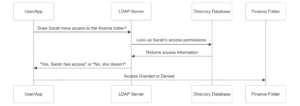What is LDAP?
Imagine you’re at a huge company with hundreds of employees. You need to find someone’s email, phone number, or even their desk location. Instead of running around with a clipboard, you’d check the company directory, right? That’s where LDAP (Lightweight Directory Access Protocol) comes in—acting like a digital company directory, making it easy to quickly access and manage employee information securely.
LDAP (Lightweight Directory Access Protocol) is like that directory, but for computers. It’s a way to store and quickly look up information about users, devices, and resources in a network. Think of it as the digital Rolodex for your organization.
How Does LDAP Work?
Let’s break it down into simple steps:
- You Ask a Question:
- You (or an app) send a request to the LDAP server. “Hey, does Sarah have access to the finance folder?”
- LDAP Checks Its Notes:
- The LDAP server looks through its organized directory (like flipping through a phonebook) to find the answer.
- LDAP Responds:
- It sends back the info: “Yep, Sarah’s got access!” or “Nope, she doesn’t.”
- Access Granted (or Denied):
- Based on the answer, you either get in or get locked out. No hard feelings, Sarah.
- Based on the answer, you either get in or get locked out. No hard feelings, Sarah.

Key Components of LDAP
Let’s meet the cast of characters:
- LDAP Server: The brainy librarian that stores all the info.
- LDAP Client: That’s you (or your app) asking the questions.
- Directory Information Tree (DIT): The organized filing system where data lives. Think of it as a family tree for your data.
- Distinguished Name (DN): A unique address for each entry in the directory. Like a social security number for data.
- Attributes: The juicy details—usernames, emails, roles, and more.
Why Should You Care About LDAP?
Here’s why LDAP is the unsung hero of IT:
- Centralized Authentication:
- One place to store all user credentials. No more sticky notes with passwords everywhere.
- Scalability:
- Works for small teams or massive enterprises. Got 10 users or 10,000? LDAP’s got your back.
- Interoperability:
- Plays nice with different systems and apps. No drama here.
- Security:
- Supports encryption and access controls. Keeps the bad guys out.
Common Use Cases for LDAP
Here’s where LDAP shines:
- User Authentication:
- “Is this person who they say they are?” LDAP checks and confirms.
- Single Sign-On (SSO):
- Log in once, access everything. No more juggling 20 passwords.
- Directory Services:
- Stores info like employee roles, departments, and permissions. Your org chart’s best friend.
- Access Control:
- Decides who gets access to what. “Sorry, interns can’t see the secret project files.”
- Integration with IAM Systems:
- Works with IAM tools to enforce security policies. Teamwork makes the dream work.
LDAP vs. Modern Protocols
LDAP has been around since the ’90s (yes, it’s older than some of your coworkers). While newer protocols like OAuth 2.0 and OpenID Connect (OIDC) are great for cloud-based systems, LDAP is still the go-to for on-premises setups. It’s like the reliable old car that still runs like a dream.

Final Thoughts
LDAP might not be the flashiest tech out there, but it’s a workhorse. It keeps your data organized, your users authenticated, and your systems secure. Whether you’re logging into your work computer or accessing a shared folder, LDAP is probably working behind the scenes to make it happen.
So next time you hear “LDAP,” think of it as your friendly digital librarian—always ready to help you find what you need. For organizations looking to enhance their directory management and security, Seamfix iAM provides seamless integration with LDAP for scalable identity and access management.









